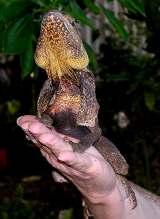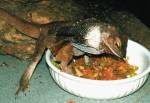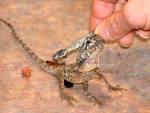|
Keeping Frillies
It seems somewhat ironic that the one reptile Australia is particularly famous for, the fascinating Frilled Lizard (Chlamydosaurus kingii), has been rather difficult for people to actually see unless they physically went to the very northern parts of Australia. Many travellers through southern regions regularly report seeing a "Frilled Lizard" in the wild, but in reality, have spotted a Bearded Dragon with its "beard" displayed. A decade ago, not many zoos or individuals kept "frillies", as captive bred stock was hard to obtain and quite difficult to keep. However, since then, both the availability of these intriguing lizards and the understanding of their needs in captivity have improved. This is largely due to a breeding program undertaken by The Royal Melbourne Zoo. Over the past few years, with the zoo's ongoing advice and support, my wife and I have also had good keeping and breeding success. We would now like to outline some of the techniques that we have adopted and developed. If you are about to acquire frillies, we hope that the suggestions in this care-sheet will be of some help. Who should keep frillies? Frillies are not lizards for beginners. In South Australia and some other states, a specialist "keep" permit is required for them. If you have successfully kept other reptiles for a number of years you may well qualify. However, if you are thinking of purchasing your first lizard, we would suggest, perhaps, a bearded dragon. "Beardies" are cheaper to purchase and easier to keep. Also, their general temperament is more suited to handling. Much of the information in the booklet "Caring for Bearded Dragons" applies equally well to the keeping of Frilled Lizards and we would suggest that a prospective frilly keeper read the booklet first. What sort of cage setup is required? It is preferable that the vivarium be at least as high as it is long. It should also be raised off the ground so that, when in the normal basking position, the occupants are at about your eye level. In the wild, frillies spend most of their lives in trees, so if you provide a number of trunks and branches, the animals will feel more at home and secure. In fact, multiple basking sites in a fairly large vivarium may allow you to keep a number of frillies together. Pine-bark potting stakes, available at some garden outlets, can be fixed to the walls or to poles to resemble small upright tree trunks. Make sure they have a rough texture and are of an adequate diameter for the lizards to hide behind. We have found that fine, clean sand is adequate for the floors of frilly enclosures. Since these animals require fairly high humidity, a large water bowl should be placed at the cooler end of the vivarium. Use a shallower bowl or put a rock in it if the lizards are too small to scramble out easily. It should be cleaned and refilled frequently. General cage construction as well as heating and UV lighting requirements are discussed in the aforementioned booklet. How many frillies can I house together? If a fairly large, tall vivarium (eg. 1000mm wide x 1000mm high x 500mm deep) with numerous basking sites is used, it is possible to keep a whole clutch of hatchling or juvenile frillies together. The same enclosure could take up to 4 sub-adult animals or 1 -2 adult lizards. Depending on their rate of growth we would consider them hatchlings at 0-3 months, juveniles at 4-12 months, sub-adults at 13-19 months and adults, capable of breeding, at about 20 months and over. Keep a careful watch for sub-adult and adult lizards that start to be intimidated by others, and relocate them, if necessary. It is unwise to house adult males together as a larger more dominant male may exhibit territorial aggression toward more submissive individuals. This could cause significant stress and possible injury. If a female appears to be gravid we suggest it be placed on its own in a vivarium with 200mm of dampened substrate made from an equal mix of peat moss and potting soil. To prevent eggs being deposited in the water, particularly with first-time mothers, the bowl should be removed when she looks like she is about to lay. If the bowl is removed and the lizard is not eating, make sure it does not become dehydrated. Egg incubation is also discussed in the previously mentioned booklet.
How should I feed my frillies? There are quite a wide variety of foods that lizards such as Bearded Dragons, Water Dragons and Frilled Lizards will eat. Once again, these are discussed at more length in that booklet but we shall now endeavour to explain how we are currently feeding our frillies. Twice a week in winter and up to three times a week in summer we head down to the reptile room to feed the lizards. This is not done first thing in the morning or very late in the afternoon, but at times when the reptiles are wide awake and alert. I assist by cleaning water bowls and cages and feeding some of the larger frillies whereas my wife usually looks after the "little guys". We use a small table, with a spotlight positioned over it, when we individually feed lizards. We discovered that feeding a group of hatchling or juvenile frillies together, in a vivarium, led to some frill damage. As a frilly eats, the frill flaps in and out, much like the opening and closing of an umbrella. This movement attracts others and can lead to the biting of frills. For this reason, insects are not just thrown into an enclosure for the occupants to chase. We did that once, and found next day that cricket escapees were actually hiding under the frill of the lizards! As well as eliminating these problems, individual feeding also ensures that hatchlings and juveniles are all feeding properly. It is not uncommon for frillies of all ages to suddenly go off their food for a week or so. However, if they are in good condition, this is not of serious concern provided they obtain regular moisture. Actually, dehydration is a common and sometimes fatal problem with frillies. Many of them don't seem to drink from a bowl as well or as often as most other captive lizards. If they are consuming plenty of moisture-containing food, they may not need to drink at all. However, if they are dehydrated, they will appear lethargic and the bulges over their eye orbits will tend to flatten. If they go off their food, this problem could easily occur and, in this case, additional water needs to be given to them. This can be achieved by dribbling it onto the end of their noses from above, using a large syringe or, alternatively, gently spraying water onto their mouths. This encourages them to begin licking. If they refuse to drink from either of these methods, the water may be put directly into their mouths using a syringe with a soft plastic tube attached. All of this is unnecessary, of coarse, if they are eating sufficient moisture-containing food.
As indicated, besides crickets and "woodies" (Speckled Feeder Roaches), we feed our lizards a "wet-mix". It consists of about 40%, by volume, of "Kitekat" tinned cat food (Beef & Vegetables variety), 40% finely grated carrot and 20% finely shredded lettuce. (Hatchlings will require these items to be cut extremely fine.) To this mix we occasionaly add a sprinkling of calcium and vitamin supplements. Most adult frillies, if left alone, will come down and feed on their own, particularly if a few drowned woodies are place on their saucer of wet-mix. Woodies will drown in about 1 minute. If they are not immobilized in this way they quite often escape whilst being fed off. We will now describe the precise method we use to feed younger individuals.
We have the meat and vegetable mix on a saucer and endeavor to attract the lizard by moving the food around with a pair of metal forceps. This movement will often start it feeding. The shine from the forceps also helps to attract the lizard. (Any feeding instruments should have sharp edges removed to avoid mouth damage). Hatchlings may, initially, not want to eat this mix. In this case we offer a small to medium cricket or a freshly drowned woodie of an appropriate size. While the lizard is still munching the insect we push some of the mixture into the side of its mouth. Further mouthfuls may then be introduced, while it is eating. Lizards that eat the mix, without needing insect enticements to begin with, are given some to conclude the feeding. Some hatchlings will feed quite easily if individually fed this way, while others may need to be force-fed, at least to begin with. It may be necessary to obtain the help of someone else to gently open its mouth and introduce an insect directly. Once it begins to eat, the follow-on feeding of the mix, as described above, may be commenced. It can be a bit messy and rather tedious but perseverance in feeding does pay off. It should be noted, at this point, that the Royal Melbourne Zoo feed their Frilled Lizards a 95% insectivorous diet. Is it true that some frillies may sulk? Yes, and this is probably one of the main reasons why people have problems keeping them. A frilly having a "sulk session" will stare into space and refuse to show interest in anything at all, including your presence. Worse still, it will stubbornly refuse to eat or drink. These mood problems tend to occur more in lizards over the age of about 6 months. For this reason, when obtaining stock it is probably advisable to seek out animals that are feeding well and are between the ages of 3-6 months. The sulking appears to be caused by a number of things, change of location probably being the most obvious one. Even being moved to another vivarium at the same location may be problematic. Over-handling, change of keeper or incompatible partner(s) may be other reasons. To help it get over this uncooperative mood, try the following: Isolate the animal. Make sure the location is quiet and that no snakes, dominant male lizards, cats and dogs or boisterous children are within its view. Make sure its vivarium is raised well off the ground and that it has branches or trunks that it can hide behind as you approach. If the animal has been relocated, place a curtain in front of the cage and slowly open it over 4-8 weeks. Persevere in getting some food and regular water into it. Ensure that daytime temperatures are adequate - around 30°C at the mid-point of the vivarium. Handle it as little as possible. It may take quite some time for an adult frilly to get over the sulks but in our experience it does, eventually, happen. How can I avoid frill damage occurring? In our experience, It is not unusual to have a little
frill damage occur over time. However, there are a few precautions that
may be taken to minimise this. In conclusion it may be said that frillies are a unique and fascinating lizard to keep. Although they may not be quite as easy to raise as Bearded or Water Dragons and are more expensive to purchase, they are, none the less, a national icon that more and more reptile enthusiasts are now able to obtain and enjoy! We would like to sincerely thank the staff of The Royal Melbourne Zoo for their ongoing support. The booklet referred to herein, "Caring For Bearded Dragons", may be obtained from some pet-shops or by contacting the S.A. Herpetology Group, C/- The S.A. Museum, North Tce., Adelaide S.A. 5000. The authors will allow this material to be copied,
in whole or in part, for educational purposes, on the proviso that it
is not added to or changed in any way or sold for profit. |




